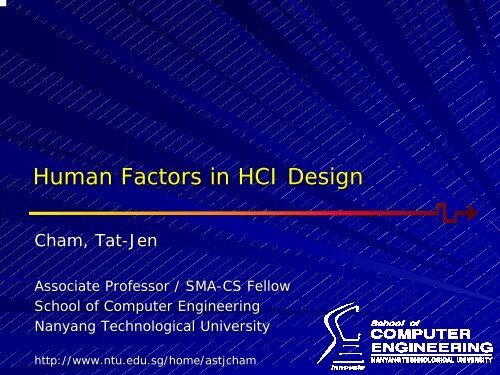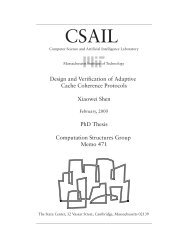Human Factors in HCI Design
Human Factors in HCI Design
Human Factors in HCI Design
You also want an ePaper? Increase the reach of your titles
YUMPU automatically turns print PDFs into web optimized ePapers that Google loves.
<strong>Human</strong> <strong>Factors</strong> <strong>in</strong> <strong>HCI</strong> <strong>Design</strong><br />
Cham, Tat-Jen Tat Jen<br />
Associate Professor / SMA-CS SMA CS Fellow<br />
School of Computer Eng<strong>in</strong>eer<strong>in</strong>g<br />
Nanyang Technological University<br />
http://www.ntu.edu.sg/home/astjcham
Pervasive Comput<strong>in</strong>g:<br />
Technology-Centric Technology Centric View<br />
Python-GTK<br />
3G<br />
Wi-Fi<br />
iPAQs /<br />
handhelds<br />
Glade<br />
Mixed-reality<br />
systems<br />
Bluetooth<br />
seamless<br />
handover<br />
L<strong>in</strong>ux<br />
Projection /<br />
OLED<br />
displays<br />
Grid comput<strong>in</strong>g<br />
Security /<br />
data protection<br />
SMA5508 /<br />
MIT6.893<br />
Student<br />
Bayesian<br />
networks<br />
Intelligent<br />
agents<br />
Smart<br />
rooms<br />
Speech recognition<br />
[speaker (<strong>in</strong>)dependent,<br />
isolated vs cont<strong>in</strong>uous speech,<br />
HMMs]<br />
Haptic Interfaces<br />
[force-feedback mechanisms]<br />
Computer vision<br />
[which really has noth<strong>in</strong>g to do<br />
with user’s visual system]
Pervasive Comput<strong>in</strong>g:<br />
<strong>Human</strong>-Centric <strong>Human</strong> Centric View<br />
Isn’t that football<br />
game on now? I’d<br />
love to watch it<br />
I’d really like to have a<br />
face-to-face conversation<br />
with Sarah <strong>in</strong> Europe, now<br />
When is my next<br />
appo<strong>in</strong>tment with John?<br />
Smith /<br />
Lim<br />
What’s the fastest way<br />
home to get out of this<br />
traffic jam?<br />
What are recent statistics of<br />
patients with the symptoms<br />
of Bob here?<br />
Heck, the pilot’s down with<br />
food poison<strong>in</strong>g. How can I<br />
land this plane?!
<strong>Human</strong>-Computer <strong>Human</strong> Computer Interfac<strong>in</strong>g<br />
Semantic Interface<br />
dataflow, scientific visualization, f<strong>in</strong>ancial<br />
account<strong>in</strong>g, remote communication<br />
Syntactic Interface<br />
shell commands + arguments, menus, icons,<br />
keyboard shortcuts, drag-n-drop, speech,<br />
gestures, handwrit<strong>in</strong>g<br />
Physical Interface<br />
keyboards, mice, display, stylus,<br />
device form factors, microphone
History of Computers<br />
Not the usual stuff<br />
Number of transistors<br />
Faster speeds<br />
Smaller sizes<br />
Power efficiency<br />
What about the user <strong>in</strong>terfaces…<br />
<strong>in</strong>terfaces
History: Physical Interfac<strong>in</strong>g 1<br />
Abacus – 3000 BC<br />
Pascalene – 1642<br />
Babbage Difference Eng<strong>in</strong>e – 1832
History: Physical Interfac<strong>in</strong>g 2<br />
ENIAC – 1946<br />
IBM 650 – 1953<br />
DEC PDP-1 – 1960
History: Physical Interfac<strong>in</strong>g 3<br />
Engelbart’s Workstation – 1966<br />
TRS-80 / Apple II– 1978<br />
IBM PC – 1981<br />
Xerox Star -- 1979<br />
Mac<strong>in</strong>tosh – 1985<br />
New iMac – 2001
History: Syntactic Interfac<strong>in</strong>g 1
History: Syntactic Interfac<strong>in</strong>g 2
History: Semantic Interfac<strong>in</strong>g<br />
VisiCalc MS Excel<br />
Quicken<br />
Matlab
The Attention Divide<br />
Early Era<br />
Mid Era<br />
Late Era<br />
Future?<br />
Mach<strong>in</strong>e Operation<br />
Software Manipulation<br />
Task Completion<br />
Mach<strong>in</strong>e Operation<br />
Software Manipulation<br />
Task Completion<br />
Mach<strong>in</strong>e Operation<br />
Software Manipulation<br />
Task Completion<br />
Mach<strong>in</strong>e Operation<br />
Software Manipulation<br />
Task Completion<br />
Enjoy<strong>in</strong>g Life
<strong>HCI</strong> <strong>Design</strong> – Involv<strong>in</strong>g the User<br />
Difficult to def<strong>in</strong>e <strong>HCI</strong> requirements specifications<br />
before-hand<br />
before hand<br />
Even harder <strong>in</strong> the pervasive comput<strong>in</strong>g era<br />
Iterative rather than open-loop open loop development<br />
process<br />
e.g. Star Model (Hartson ( Hartson & Hix, Hix,<br />
1989) c.f. Waterfall Model<br />
Prototyp<strong>in</strong>g<br />
Prototyp<strong>in</strong>g<br />
Implementation<br />
Implementation<br />
Evaluation<br />
Evaluation<br />
Conceptual<br />
Conceptual<br />
/<br />
/<br />
formal<br />
formal<br />
design<br />
design<br />
Task<br />
Task<br />
/<br />
/<br />
functional<br />
functional<br />
analysis<br />
analysis<br />
Requirements<br />
Requirements<br />
specification<br />
specification
<strong>HCI</strong> <strong>Design</strong> Guidel<strong>in</strong>es<br />
Reflexive (Motor-Sensory)<br />
(Motor Sensory)<br />
M<strong>in</strong>imize bra<strong>in</strong> cycles needed to use the<br />
<strong>in</strong>terface (“muscle ( muscle memory”)<br />
memory<br />
Cognitive<br />
Allows users to harness <strong>in</strong>tuitive,<br />
problem-solv<strong>in</strong>g problem solv<strong>in</strong>g skills<br />
Social / Organizational<br />
Meet requirements for multi-person<br />
multi person<br />
<strong>in</strong>teraction
Reflexive Considerations<br />
Intuition versus learn<strong>in</strong>g<br />
simplicity versus completeness<br />
/ efficiency?<br />
Accuracy-speed Accuracy speed tradeoff<br />
ROC curve<br />
User feedback<br />
visual, aural, tactile<br />
Motor-sensory Motor sensory channel<br />
separation<br />
e.g. is gaze cursor control a<br />
good <strong>in</strong>terface?<br />
Ergonomics<br />
M<strong>in</strong>imize physical stra<strong>in</strong> on<br />
users<br />
www.5dt.com<br />
Twiddler<br />
HP Tablet PC<br />
www.eyegaze.com
Reflexive Performance Studies:<br />
Evaluation and Model<strong>in</strong>g<br />
Evaluations are typically based on tim<strong>in</strong>g<br />
experiments<br />
Keystroke-Level Keystroke Level Model<br />
Card, Moran & Newell 1980<br />
Task time = Σ (unit tasks time)<br />
Unit tasks: Keystrok<strong>in</strong>g, Keystrok<strong>in</strong>g,<br />
Po<strong>in</strong>t<strong>in</strong>g,<br />
Hom<strong>in</strong>g, Draw<strong>in</strong>g, Mental, Response<br />
Modified Fitts’ Fitts Law<br />
Applicable to po<strong>in</strong>t<strong>in</strong>g tasks<br />
movement ⎛ distance ⎞<br />
⎜<br />
⎟<br />
time<br />
= a + b log2<br />
+ 1<br />
⎝ target width<br />
⎠<br />
Steer<strong>in</strong>g Law (Accot Accot & Zhai 1997) 1997<br />
Navigation of menus<br />
Images from Buxton 2003
Cognitive Considerations<br />
Metaphors<br />
Info visualization<br />
Visual programm<strong>in</strong>g<br />
Anthropomorphism<br />
Cognitive load<br />
Fatigue, stress of task<br />
automation vs user choice<br />
Focus of attention<br />
multi-task<strong>in</strong>g<br />
multi task<strong>in</strong>g<br />
how easy is it to return to<br />
a suspended task?<br />
User Model<strong>in</strong>g<br />
Interfaces tailored to<br />
<strong>in</strong>dividuals<br />
Khoros – Cantata<br />
MSR data mounta<strong>in</strong><br />
HP CRL –<br />
Smart Kiosk
Social and Organizational<br />
Considerations<br />
Synchronized experience<br />
Massive multiplayer games<br />
‘<strong>in</strong>stant <strong>in</strong>stant’ messag<strong>in</strong>g, but typ<strong>in</strong>g<br />
latency?<br />
Organizational order<br />
Onl<strong>in</strong>e roles and process flow<br />
e.g. teach<strong>in</strong>g groupware have<br />
onl<strong>in</strong>e roles for <strong>in</strong>structors, TAs<br />
and students<br />
Social norms<br />
privacy<br />
<strong>in</strong>stant messag<strong>in</strong>g – should onl<strong>in</strong>e<br />
state be revealed?<br />
what should default umasks be?<br />
etiquette<br />
tak<strong>in</strong>g turns dur<strong>in</strong>g tele-<br />
collaboration<br />
smileys – better or worse?<br />
America’s Army
Prototyp<strong>in</strong>g and Evaluation<br />
Wizard of Oz Prototyp<strong>in</strong>g<br />
<strong>Human</strong> `wizard’ `wizard to simulate<br />
mach<strong>in</strong>e <strong>in</strong>teraction<br />
Faster prototyp<strong>in</strong>g<br />
elim<strong>in</strong>ates programm<strong>in</strong>g<br />
overhead<br />
Usability Studies<br />
Task completion time, # errors / task,<br />
learn<strong>in</strong>g curve, function frequency<br />
distribution<br />
User satisfaction and feedback<br />
Physiological measurements?
Future Challenges<br />
As computers and comput<strong>in</strong>g<br />
become pervasive…<br />
pervasive<br />
what are the best <strong>in</strong>terfaces?<br />
how do we effectively move beyond<br />
keyboards, mice, screens, WIMP?<br />
Should we?<br />
Interfaces that<br />
comb<strong>in</strong>e cool technology, and<br />
satisfy human-centric human centric demands
References<br />
Bill Buxton, Less is More (More or Less), Less) , 2001<br />
http://www.billbuxton.com/LessIsMore.html<br />
J. Preece, Preece,<br />
Y. Rogers, H. Sharp, D. Benyon, Benyon,<br />
S.<br />
Holland, T. Carey, <strong>Human</strong>-Computer <strong>Human</strong> Computer Interaction,<br />
Interaction,<br />
Addison-Wesley, Addison Wesley, 1994<br />
Marc Rettig, Rettig,<br />
Interaction <strong>Design</strong> History <strong>in</strong> a Teeny<br />
Little Nutshell, Nutshell,<br />
2003<br />
http://www.marcrettig.com/writ<strong>in</strong>gs/rettig.<strong>in</strong>teractionDe<br />
signHistory.2.03.pdf<br />
CHI – ACM SIGCHI Conference on <strong>Human</strong> <strong>Factors</strong><br />
<strong>in</strong> Comput<strong>in</strong>g Systems

















